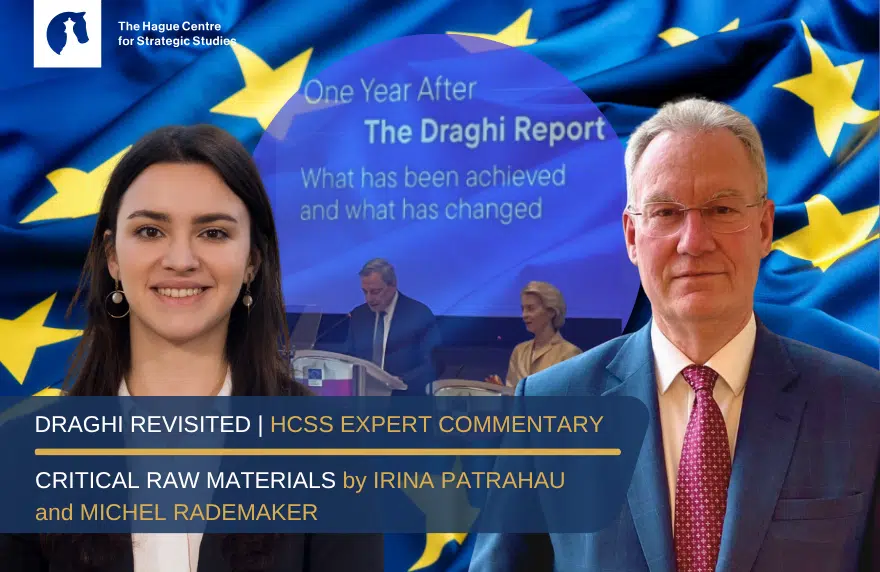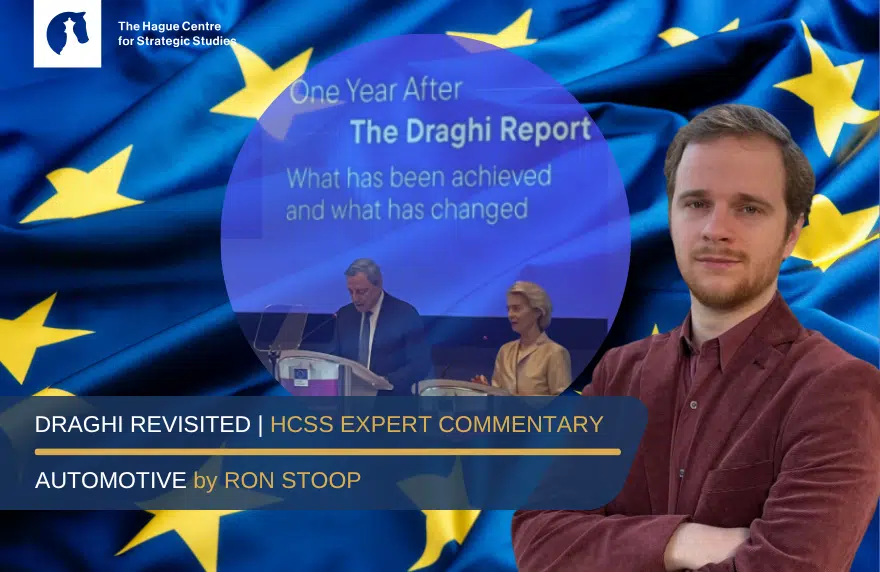One year after Mario Draghi’s landmark report on Europe’s economic future, HCSS launches the second edition of its Draghi Report Series.
Despite political attention, Europe still struggles with dependencies in defence, raw materials, cleantech, and digital domains. Global tensions with both China and the US are mounting, and Europe’s trade model faces unprecedented pressure. Progress has been uneven and often too slow due to coordination, financing and other internal barriers.
Last year, analysts Ron Stoop and Berend Kwak examined the long-term implications of Draghi’s recommendations. Now, they return to assess how far Europe has come in addressing his urgent call to secure industrial, technological and economic sovereignty.
In this new series, HCSS experts revisit Draghi’s warnings sector by sector.
For the second article, strategic analyst Irina Patrahau and deputy director Michel Rademaker take a closer look at the feasibility of the EU’s plans for the Critical Raw Materials (CRM) sector.
Since the publication of the Draghi Report, what concrete steps have been taken at the EU and member state level in the Automotive sector, and how effective have they been so far?
Irina Patrahau: The EU has been working to deliver the ambitions under the Critical Raw Materials Act – negotiating trade agreements with resource rich countries, selecting and promoting strategic projects, and trying to boost stockpiling. The European Commission is creating an enabling framework for companies to make investments and build new supply chains.
The biggest challenge remains cost. So far, the key determinant of whether this enabling framework has led to concrete outcomes is the commitment of national governments to projects. National governments have more leeway than the EU to offer direct investments or indirect financing support to companies, overcoming the initial cost challenge. France is emerging as a rare earths hub within the EU. The first European lithium refinery opened in Germany. It is no coincidence that France and Germany are seeing significant progress. They are also two of the European governments most committed to strengthening mineral supply security, supporting companies both legislatively and with funding.
Unfortunately, this is a short-term solution to a systemic issue. As of now, the effectiveness of the EU’s actions, especially considering the lack of EU funding for mining, processing and recycling, is strongly dependent on member states’ ability to provide credible long-term guarantees to their industry. Moving forward, it is essential for the EU and members to reduce energy costs, introduce non-price criteria for ‘Made in Europe’, and find innovative ways to develop offtake agreements, for instance through stockpiling.
Michel Rademaker: Since the Draghi Report, some CRM projects have been announced, but the progress is modest compared to the scale of Europe’s needs. The Critical Raw Materials Act (CRMA) set ambitious targets, which are unlikely to be met. On paper, there is momentum: 47 strategic projects have been announced in Europe. However, so far it has not resulted in a functioning ‘de-risked’ supply chain, and there is no indication that this will change in the near future. The main critique on the CRMA is that it lacks financial incentives to actually push these projects forward. A few local projects are coming through, but they are modest in scale and more the result of national imperatives than successful EU-level coordination.
A slew of EU legislation and requirements have been announced to buttress the CRM (processing) and downstream industries in Europe. Nevertheless, a lot of basic industries in the EU are seriously struggling because of high energy prices and foreign dumping on the internal market. These developments do not support the development of robust CRM supply chains but will rather depress demand for CRM in Europe, further deteriorating the business case for additional recycling and processing.
Where do the biggest gaps lie between political ambition and practical implementation, and why do they exist?
Irina Patrahau: Progress in building a robust European industry after a long period of neglect is inherently slow – not just when it comes to reopening a mine or building a recycling facility, but also, and especially when it comes to changing mindsets. In Brussels and some major European capitals, the geopolitical risks to economic security are easily translated into the need to invest in the CRM industry. But the urgency is not equally felt in all European countries. Nor is it felt at all the provincial and municipal levels, where many decisions on industrial operations are made. There is still a major gap in understanding the challenge and matching it with the right solution, because geopolitical and geoeconomic risks were not something industry and policymakers had to deal with for a long time. Investing in awareness, education and up-skilling is essential to make the EU future-proof.
Michel Rademaker: The main problems in the European mining industry remain the same. Firstly, permitting remains too slow. We don’t have decades to wait for the first mines to reopen. These frustrations are exacerbated by local opposition and lengthy procedures, stalling key projects. Recycling is still underdeveloped, and downstream demand is lacking. The lack of effective EU coordination for permitting fragmented financing and weak incentives for private investors to provide capital have frustrated progress in the EU. As it stands, Europe is still almost entirely dependent on China for refining rare earths and most other CRM.
Looking ahead, what should be the EU’s top two or three priorities to stay competitive, and where might it make sense to scale back?
Irina Patrahau: Apart from finding systemic solutions to reduce costs and investing in education, which I mentioned above, having a European approach to supply chains is essential for the coming years. There is no need to have 27 lithium refineries or 27 mineral stockpiling systems. Considering the challenge ahead – building resilient supply chains for 34 CRM – the best choice is to combine efforts, taking advantage of each other’s strengths and minimizing relative weaknesses. The Netherlands is a hub for scrap metal, but a lot of it is exported. The answer is not just to build more recycling facilities in the Netherlands. Rather, it is to collaborate with existing and emerging recycling facilities in other countries. This would not just bring more secondary materials for consumption in the EU but also create a business case for emerging recycling plants that may struggle with competitiveness. I cannot overstate the importance of thinking European to enhance supply chain security.
Michel Rademaker: The top priority should be to accelerate projects already in development. The EU-identified strategic projects should receive more support to regain momentum. The second priority should be to strengthen the circular economy. Mandating the use of recycled critical raw materials in batteries and magnets would create significant local demand and scale up urban mining. The third priority is to build strategic stockpiles, as recommended in the Draghi and Letta reports, so that supply shocks cannot paralyze Europe’s industries. Several countries are researching the possibilities, and the EU is preparing plans to do the same, but the speed at which it happens is not fast enough. Strategic stockpiles could be a relatively cheap life insurance in case more strategic raw materials will experience supply disruptions, severely impacting key downstream sectors within the EU.
If we meet again in a year, what single measurable outcome would convince you that Europe is on the right track in this sector?
Irina Patrahau: At least one cross-European mining-refining-production-recycling supply chain with a clear long-term plan to overcome cost challenges and reach commercial operations would be quite convincing to me.
Michel Rademaker: A key indicator for success is the development of projects in the EU itself. There are a few projects set to come online in 2026 in Finland, Germany and France. If these projects become operational, that would provide much needed momentum for the EU.










